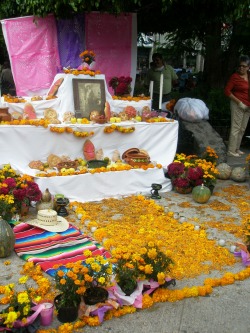Far from the spooky orange and black decorations that mark the Halloween “season” back at home, here in Mexico Dia de los muertos (Day of the Dead) is celebrated with bright purple, pink, orange, and red colors.

Between October 31 and November 2 – and in the weeks leading up to Dia de los muertos - the street corners are bursting with flowers and the sweet aroma of pan de muerto (a soft bread) wafts out of storefront bakeries. Meanwhile, in cemeteries, families wash their loved ones’ graves and lay fresh flowers as well as the favorite foods and beverages of the deceased.
A group of us had the chance to experience more of this on Sunday both in Cuernavaca and also in a small town called Ocotepec. First, a public garden showcased lots of creatively decorated Catrinas (skeleton figures) and an elaborate ofrenda (offering, or altar) was on display in the Zocalo, much like the ofrendas that are made to the deceased by family members in their homes.
Later that night in Ocotepec we began by following trails of marigold petals along narrow cobblestone streets until we spotted a line forming outside of a home. Those who have lost a loved one in the past year open their homes to family, friends, neighbors, and complete strangers. Everyone is invited. It’s said that on Dia de muertos that the dead return home to commune with the living by feasting on the food and drink that is put out on the ofrenda. In some cases, the whole room becomes an ofrenda! At each house we passed under a canopy of flowers that spelled out the words: “Welcome home” – a greeting for the dead and not just the living – and each visitor gives the host a candle in exchange for a piece of bread, coffee, a tamal, or ponche (a warm fruit drink).
All this is a joyful time for remembering the deceased person and enjoying the company of many guests. It was a unique experience to come to know not only how special each person was to her or his family but also to see an elaborate display (which probably took days to construct) of their clothes, pictures, and all the other things they enjoyed when they were living.
At first glance, the skulls and candles might trigger images of death, or it could be that the festive colors and expressive, humorous skeletons make it seem like Halloween-light. My thoughts went back and forth between those two reactions. But now I see that Dia de los muertos is much more. Instead it’s a unique ritual and celebration of life – and in a way it almost mocks death. For Mexicans, this week a special time of mourning and celebration, physical and spiritual, life and death - symbolized in the flowers, sugar skulls, fruit, incense and candles that are placed on families’ ofrendas (offerings). It’s a reminder to honor and embrace duality, rather than fear it. What better way to celebrate life?
* Thanks, Katherine, for the pictures!